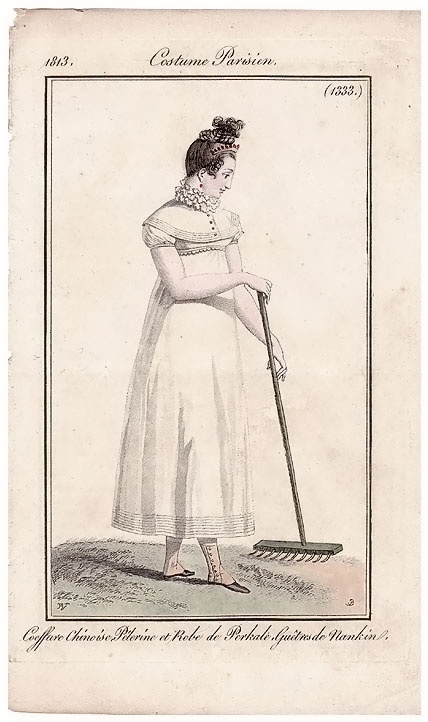For the fifth Historical Sew Fortnightly challenge of 2015 (due by May 31st), we’re getting down and dirty and making something that is about getting work done: building up, cleaning up, fixing up, and generally being practical.
Fancy party frocks are all very well, but everyone, even princesses, sometimes needs a practical garment that you can DO things in. In this challenge we’re creating the jeans-and-T-Shirt-get-the-house-clean-and-garden-sorted outfit of your chosen period.
This challenge is particularly interesting, because the get-work-done outfits are the ones that are least likely to survive. People keep their special occasion garments: their wedding outfits, party frocks, and delicate pieces, and museums are full of these, but who has a paint-spattered, slightly ripped, well worn T-shirt and their gardening jeans carefully preserved for posterity? It’s a bit ironic, as we’ll spend more time in these type of garments than in our posh togs.
So, let’s focus on work aprons, wash frocks, slat bonnets, shorter skirts, basic blouses, short gowns, and other working garments: the unsung wardrobe heroes of the past.
For many periods in the past, and for many people, their entire wardrobe would have been working clothes. Their have always been more workers than rulers, and if you are building pyramids in ancient Egypt, cathedrals in Medieval Europe, garrisons in frontier America, or railroads in Victorian England, or growing or preparing the food that fuelled all of this, your clothes will need to accommodate this.
Practically doesn’t have to be all about working class garments: even the upper classes and royalty needed practical garments on occasion.
And by practical garments, I’m not thinking of outfits for playing at being peasants, like Marie Antoinette’s famous pretend shepherdess frocks, or frilled organza aprons that were only good for pretending to cover your frock while you played hostess and your servants did all the work, but garments that really were about being practical.
One famous example that comes to mind is that of the young Alexandra of Denmark, later Princess of Wales and Queen of England. When she first met her future mother-in-law, Queen Victoria was quite impressed by Alexandra, because she wore the same jacket with different skirts two days in a row. Victoria saw this as a sign that Alexandra had the practical, down-to-earth temperament needed to keep the Crown Prince in check. She didn’t realise that it was necessity: Alexandra might be royalty, but her family was so impoverished that she and her sisters made their own clothes, and waited tables when her parents entertained.
Alexandra’s clothes from later in life certainly weren’t practical, but for the teenage Alexandra, most clothes would have been made to be worked in.
Margaret Hale must also have practical clothes for being “Peggy the laundry maid” and other tasks in which she might be “a born and bred lady through it all, even though it comes to scouring a floor or washing dishes.”
And one can well imagine that while the Bennet girls might not need to know how to cook, a simpler dress or an apron for more ladylike household tasks would certainly have come in useful.
One of my favourite Costume Parisien fashion plates (from 1813): is a perfect example of a fashionable lady being practical. An all-white frock for raking might not be the best choice, but her nankeen gaiters are a smart choice.
For more inspiration, you might find these posts and pinterest boards useful – note that not all the images in all of them apply, as sometimes they feature ‘best’ clothes:
The inspiration post for HSF ’13’s Peasants & Pioneers challenge
Artworks featuring Labourers at the Yale Centre for British Art
Italian working class dress 1575-1600 at Festive Attire
1700-1800 Working class clothes
Images of Working women and their dress
Fashions for domestic help, 1906
Sensible frocks for daily wear, 1911
1930s Hooverettes at Festive Attyre
Land Girl overalls at the Museum of New Zealand Te Papa Tongarewa


I’m looking forward to this one! It fits in well with my aim to only make things that will actually be used.
teenagetailoress.wordpress.comteenagetailoress.wordpress.comI’m sorry that I couldn’t do the April challenge (I might have something up my sleeve I can pull out at the last minute though), but I have already started this project! It’s a great one with such wide variety of choice.
http://www.teenagetailoress.wordpress.com
Done and blogged:
https://wandabvictorian.wordpress.com/2015/03/16/hsm-challenge-5-practicality/
I’ve been sewing plenty, but don’t always have time to blog. Thank you so much for hosting the Historical Sew Monthly, Leimomi! It’s inspiring, tons of fun, and a great learning experience.
Can’t wait to finish this one! I might finally be on time! I’ll be doing a pinner apron for my 1860’s ensemble.
Done! Mid-16th Century linen dress
http://isabelladangelo.blogspot.com/2015/05/historical-sew-monthly-practicality.html
Here is my 1920’s sheer kimono robe!
http://aimeevictorianarmoire.com/2015/05/27/hsm-practicality-1920s-kimono/
[…] j’ai decouvert le challenge n°5 du Historical Sew Monthly qui visait à nous faire coudre une pièce à usage pratique, j’etais vraiment contente, et […]
My Twenties’ house dress: https://aboutmybuttonbox.wordpress.com/2015/05/29/hsm-5-practicality-the-homemaker-dress/
My Civil War pinner apron is finally Blogged! It’s been finished for over a week, haha! http://returningvintage.blogspot.com/2015/05/may-sew-monthly-challenge.html
Practicality was the perfect challenge for May as I finished a refashioned 1800s short gown! Hopefully, as the first of four planned short gown studies to come: http://youngsewphisticate.blogspot.com/2015/05/short-gown-studies-i.html
My practicality challenge, an apron circa 1943.
http://levagabondage.blogspot.com/2015/05/hsf-challenge-practicality.html
Here is my 1930s House-Apron!
http://zeitenzauberin.blogspot.de/2015/05/a-practical-apron.html
I made a shirt.
http://mouseborgdesigns.blogspot.ca/2015/05/cotton-shirt-2.html
nigdziekolwiek.comnigdziekolwiek.comSome everyday clothes of 10th century Slavic woman. Not the full set but zapaska/panova and a dress is a good start. (English version still under translation) http://www.nigdziekolwiek.com/?p=1975
Bodiced petticoat for the win! (I love this thing already) http://adventuresinbiastape.blogspot.ca/2015/05/hsm-15-5-practicality-regency-bodiced.html
This is the first challenge I’ve done! I made a sunbonnet and am very happy with how it came out!
http://thesewinggoatherd.blogspot.com/2015/06/a-very-practical-sunbonnet.html
Welcome! It looks great and I look forward to seeing more of your entries!
Late Bustle Era wrapper!
http://thedreadedseamstress.blogspot.com/2015/06/historical-sew-monthly-5-practicality.html
sewhistorically.comI’ve sewn a 1900s gingham wash dress with apron and cap.
http://www.sewhistorically.com/historical-sew-monthly-1900s-gingham-wash-dress/
My post for practicality is a late 30s pants and blouse for photojournalist Dorothea Lange. https://romancingthesewn.wordpress.com/2015/05/31/hsm-challenge-5-practicality-dorothea-lange-and-the-dust-bowl/
I’m super LATE on mine, but I wanted to finish all the challenges! Life (family health issues and moving) got in the way of any sewing time April/May/June, so I’m catching up with the late challenges, and now all caught up, yay.
For this challenge I created a late 18th century fashion apron, to make a 1770’s gown more ‘practical’…http://theladydetalle.blogspot.com/2015/12/a-delicate-late-18th-century-apron-may.html